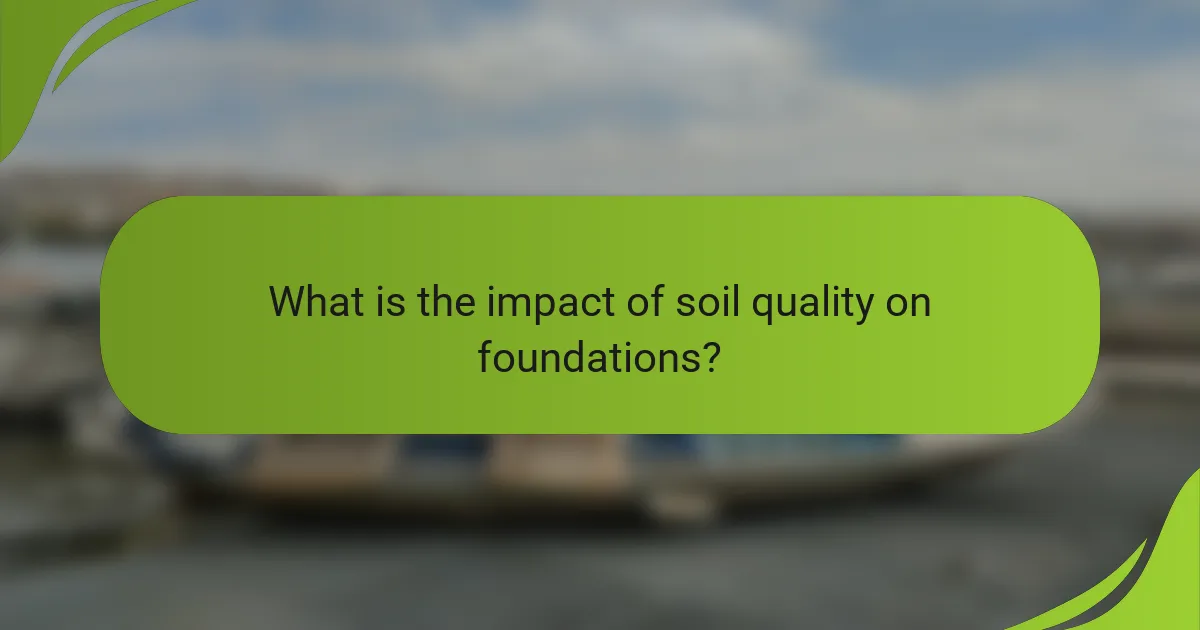Soil quality is a critical factor influencing the stability and durability of building foundations. Poor soil conditions, such as expansive clay or loose soils, can lead to significant structural issues, including uneven settling and foundation movement. Research indicates that approximately 70% of foundation failures are linked to soil-related problems, underscoring the importance of thorough soil testing. Various testing methods, including physical, chemical, and biological analyses, are essential for assessing soil characteristics like bearing capacity and moisture content. Understanding these factors is vital for effective soil management and ensuring foundation integrity.

What is the impact of soil quality on foundations?
Soil quality significantly impacts the stability and durability of foundations. Poor soil quality can lead to uneven settling, which compromises structural integrity. For instance, expansive clay soils can swell when wet and shrink when dry, causing foundation movement. According to the American Society of Civil Engineers, nearly 25% of foundation failures are due to inadequate soil conditions. Additionally, loose or poorly compacted soils can result in increased settlement over time. This can lead to cracks in walls and floors, and in severe cases, structural failure. Proper soil testing before construction is essential to evaluate soil bearing capacity and moisture content.
How does soil quality affect the stability of foundations?
Soil quality significantly affects the stability of foundations. Poor soil quality can lead to uneven settlement. This unevenness can cause structural damage over time. Soil types, such as clay, sand, and silt, have different load-bearing capacities. Clay, for instance, expands when wet and shrinks when dry, leading to instability. In contrast, sandy soils drain well and provide better support. Soil compaction is also crucial; well-compacted soil increases foundation stability. The American Society of Civil Engineers states that inadequate soil quality contributes to over 25% of structural failures. Therefore, assessing soil quality is essential for safe foundation design.
What are the key characteristics of soil quality that influence foundations?
The key characteristics of soil quality that influence foundations include soil composition, density, moisture content, and bearing capacity. Soil composition affects the stability of the foundation. Different soil types, such as clay, sand, and silt, have varying load-bearing abilities. Density determines how compact the soil is, impacting its strength and stability. Moisture content influences soil behavior, particularly in clay soils, which can expand or contract with water. Bearing capacity is the maximum load the soil can support without failure. According to the American Society of Civil Engineers, understanding these characteristics is essential for designing safe and effective foundations.
How do different soil types impact foundation integrity?
Different soil types significantly impact foundation integrity. Soil composition affects load-bearing capacity, drainage, and settlement. Clay soils can expand and contract with moisture changes, leading to foundation movement. Sandy soils typically provide good drainage but may lack stability under heavy loads. Loamy soils balance moisture retention and drainage, often providing a stable foundation. According to the American Society of Civil Engineers, improper soil assessment can lead to structural failures. Therefore, understanding soil types is crucial for ensuring foundation stability and longevity.
Why is understanding soil quality essential for construction?
Understanding soil quality is essential for construction because it directly affects the stability and safety of structures. Soil quality determines load-bearing capacity, drainage properties, and susceptibility to erosion. Poor soil quality can lead to foundation failure, causing costly repairs and safety hazards. According to the American Society of Civil Engineers, inadequate soil assessment contributes to 25% of structural failures. Soil testing identifies composition, density, and moisture levels, which are critical for design and engineering decisions. Proper understanding of soil conditions ensures appropriate foundation design, reducing risks associated with settling and shifting.
What risks are associated with poor soil quality for foundations?
Poor soil quality poses significant risks to foundations. It can lead to structural instability. Weak soil may not support the weight of the building. This can cause settling or shifting over time. Uneven settling can result in cracks in walls and floors. Poor drainage can exacerbate these issues by causing erosion. Soil with high clay content can expand and contract, leading to further damage. Additionally, contaminated soil can compromise the integrity of materials used in construction. These factors collectively increase the likelihood of costly repairs and safety hazards.
How can soil quality assessments prevent foundation issues?
Soil quality assessments can prevent foundation issues by identifying problematic soil conditions. These assessments evaluate soil composition, density, and moisture levels. Poor soil can lead to settling, shifting, or cracking of foundations. For instance, clay soils expand when wet and shrink when dry, causing instability. A study by the American Society of Civil Engineers indicates that 25% of structural failures are linked to inadequate soil assessments. By conducting thorough soil tests, builders can make informed decisions on foundation design. This proactive approach minimizes the risk of future foundation problems.

What are the testing methods for assessing soil quality?
Testing methods for assessing soil quality include physical, chemical, and biological analyses. Physical tests measure soil texture, structure, and moisture content. Common methods are particle size analysis and bulk density determination. Chemical tests evaluate pH, nutrient levels, and contaminants. Techniques like soil extraction and spectrophotometry are frequently used. Biological assessments involve measuring microbial activity and organic matter content. Methods include respiration tests and biomass estimation. Each method provides crucial data that informs soil management practices and foundation stability.
How do geotechnical tests determine soil properties?
Geotechnical tests determine soil properties through various methods that evaluate physical and mechanical characteristics. These tests include sampling, in-situ testing, and laboratory analysis. Sampling involves collecting soil specimens from different depths for examination. In-situ testing measures soil properties directly at the site using techniques like Standard [censured] Test (SPT) and Cone [censured] Test (CPT). Laboratory analysis tests the collected samples for attributes such as grain size, plasticity, and shear strength. Results from these tests inform engineers about soil behavior under load. For example, the Atterberg limits test assesses soil plasticity and helps predict its usability in construction. Accurate soil property determination is crucial for foundation design and stability.
What are the most common soil testing methods used in construction?
The most common soil testing methods used in construction include Standard [censured] Test (SPT), Cone [censured] Test (CPT), and laboratory soil analysis. The Standard [censured] Test involves driving a split-spoon sampler into the soil to collect samples and assess soil density. The Cone [censured] Test uses a cone-shaped penetrometer pushed into the ground to measure soil resistance and provide detailed profiles. Laboratory soil analysis examines collected samples for properties like grain size, moisture content, and shear strength. These methods help determine soil characteristics critical for foundation design and stability.
How do laboratory tests differ from field tests in soil analysis?
Laboratory tests differ from field tests in soil analysis primarily in their environment and methodology. Laboratory tests are conducted in controlled settings, allowing for precise measurements of soil properties. These tests can analyze parameters like grain size, moisture content, and chemical composition. In contrast, field tests are performed on-site, reflecting actual soil conditions. They often assess soil behavior under real-world stresses, such as compaction and load-bearing capacity.
Laboratory tests yield consistent and repeatable results due to controlled conditions. For example, a standard Proctor test measures soil compaction in a lab. Field tests, such as the Standard [censured] Test (SPT), provide immediate data on soil strength and density. The results from laboratory tests can be more accurate for specific analyses, while field tests offer practical insights into soil performance.
What role do soil tests play in foundation design?
Soil tests are crucial for foundation design as they determine the soil’s bearing capacity and stability. These tests assess soil properties such as density, moisture content, and composition. Accurate soil analysis helps engineers design foundations that can support the intended load. For instance, a soil test may reveal weak layers that require additional support or different foundation types. The data from these tests guide decisions on foundation depth and type, ensuring safety and durability. According to the American Society of Civil Engineers, improper soil assessment can lead to structural failures. Thus, soil tests are essential for informed and effective foundation design.
How can soil test results inform foundation type selection?
Soil test results inform foundation type selection by providing critical data on soil properties. These properties include soil composition, density, moisture content, and bearing capacity. For example, clay soils expand and contract with moisture changes, affecting foundation stability. Sandy soils offer better drainage but may require deeper foundations. Soil tests reveal the load-bearing capacity needed for specific structures. Engineers use this data to determine whether a shallow or deep foundation is appropriate. Accurate soil analysis helps prevent costly structural issues. Inadequate foundation choices based on poor soil understanding can lead to settlement or cracking. Thus, informed decisions based on soil tests enhance building longevity and safety.
What are the implications of soil test results on construction safety?
Soil test results have significant implications for construction safety. They inform the structural integrity of foundations. Poor soil quality can lead to settlement and instability. This instability may result in structural failure. Soil tests assess parameters like compaction, moisture content, and contamination. For example, a study by the American Society of Civil Engineers found that inadequate soil testing increases the risk of foundation issues. Proper soil analysis can guide appropriate foundation design. It also helps in selecting suitable construction methods. Overall, soil test results are crucial for ensuring safe and durable construction.

What are the effects of soil quality on foundation performance?
Soil quality significantly affects foundation performance. Poor soil quality can lead to inadequate load-bearing capacity. This may result in foundation settlement or shifting. High moisture content in soil can cause expansion or contraction. Such changes can create stress on foundations. Soil composition, including clay or sand, influences stability. For instance, clay soils retain water and expand, while sandy soils drain quickly. Research shows that 70% of foundation failures relate to soil issues. Proper soil testing can identify risks before construction.
How does poor soil quality lead to foundation failure?
Poor soil quality can lead to foundation failure due to inadequate support and instability. Soil that is weak or improperly compacted cannot bear the weight of structures effectively. This can result in uneven settling, causing cracks in the foundation. Additionally, expansive soils, such as clay, can swell when wet and shrink when dry. This movement creates pressure on foundations, leading to structural damage. According to the American Society of Civil Engineers, improper soil conditions are a leading cause of foundation issues. Inadequate drainage can also exacerbate soil quality problems, increasing moisture levels and reducing soil strength. Ultimately, these factors contribute to significant foundation failure risks.
What are the signs of foundation problems caused by soil issues?
Signs of foundation problems caused by soil issues include cracks in walls and floors. These cracks often appear as diagonal fissures near windows or doors. Uneven or sloping floors can also indicate foundation instability. Doors and windows may become difficult to open or close, signaling misalignment. Additionally, gaps between walls and ceilings may widen over time. A noticeable increase in moisture or water pooling around the foundation can exacerbate soil-related issues. Lastly, signs of soil erosion or settling around the foundation are critical indicators of underlying problems. These symptoms collectively suggest that soil conditions are negatively affecting the foundation’s integrity.
How can soil erosion impact foundation stability?
Soil erosion can significantly impact foundation stability. Erosion removes the soil that supports a foundation. This loss of support can lead to uneven settling. Uneven settling creates structural stress on buildings. Over time, this stress can cause cracks in walls and floors. Additionally, erosion can change drainage patterns. Poor drainage can lead to water accumulation around the foundation. This further weakens the soil and increases the risk of foundation failure. Research indicates that homes built on eroded soil are more prone to structural issues.
What solutions exist for mitigating soil quality issues?
Solutions for mitigating soil quality issues include soil amendments, crop rotation, and cover cropping. Soil amendments, such as organic matter and nutrients, improve soil structure and fertility. Crop rotation reduces pest and disease buildup while enhancing soil nutrient profiles. Cover cropping prevents erosion and enhances soil moisture retention. These practices contribute to sustainable soil management. Research shows that integrated approaches significantly improve soil health and resilience. For instance, a study by the USDA found that organic amendments can increase soil organic carbon by up to 30%.
How can foundation designs adapt to poor soil conditions?
Foundation designs can adapt to poor soil conditions through various engineering techniques. One method is to use deep foundations, such as piles or caissons, which transfer loads to deeper, more stable soil layers. Another approach is to employ mat foundations, which distribute the building’s weight over a larger area, reducing pressure on weak soil. Soil stabilization techniques, like compaction or chemical treatment, can also improve the load-bearing capacity of the soil. Additionally, engineers may design flexible foundations that can accommodate soil movement. These adaptations are crucial in preventing structural damage and ensuring safety. Studies show that using appropriate foundation techniques can significantly reduce settlement issues in poor soil conditions.
What soil improvement techniques can enhance foundation support?
Soil improvement techniques that enhance foundation support include compaction, grouting, and soil stabilization. Compaction increases soil density, which improves load-bearing capacity. Grouting involves injecting a fluid material to fill voids and increase soil strength. Soil stabilization uses additives like lime or cement to enhance soil properties. These methods can significantly reduce settlement and increase stability. For example, a study by the Federal Highway Administration found that soil stabilization can increase the bearing capacity by up to 300%. This evidence supports the effectiveness of these techniques in enhancing foundation support.
What best practices should be followed for ensuring foundation stability?
To ensure foundation stability, proper soil assessment and preparation are essential. Conduct soil tests to determine its bearing capacity. This includes analyzing soil type, moisture content, and compaction level. Use appropriate foundation designs based on soil characteristics. For instance, deep foundations may be necessary for weak soils. Drainage systems should be installed to prevent water accumulation around the foundation. Regular maintenance of landscaping can also mitigate water issues. Additionally, monitor for soil erosion and make necessary reinforcements. Following these practices can significantly enhance foundation stability.
How can regular soil assessments contribute to long-term foundation health?
Regular soil assessments contribute to long-term foundation health by identifying soil properties that affect stability. These assessments evaluate factors like moisture content, compaction, and pH levels. Understanding these properties helps in predicting potential soil movement. Soil movement can lead to foundation settlement or heaving. Regular assessments allow for timely interventions to mitigate these risks. For instance, adjusting drainage systems can prevent soil saturation. Research indicates that proactive soil management can extend the lifespan of foundations. According to a study published in the Journal of Geotechnical and Geoenvironmental Engineering, proper soil assessment reduces foundation repair costs by up to 30%.
What preventative measures can be taken during construction to address soil quality concerns?
Preventative measures during construction to address soil quality concerns include soil testing, proper drainage, and erosion control. Soil testing identifies contaminants and compaction levels. Proper drainage systems prevent water accumulation that can degrade soil quality. Erosion control measures, such as silt fences and vegetation, protect against soil loss. These practices help maintain soil integrity and support stable foundations. Implementing these measures reduces risks associated with poor soil quality, ensuring safer construction outcomes.
The primary entity of this article is soil quality and its impact on foundations. The article examines how various soil characteristics, such as composition, density, and moisture content, influence foundation stability and integrity, highlighting that poor soil conditions can lead to significant structural failures. It discusses essential soil testing methods, the implications of soil quality on construction safety, and solutions for mitigating soil issues, including soil improvement techniques and best practices for foundation design. The article emphasizes the importance of regular soil assessments in maintaining long-term foundation health and preventing costly repairs.